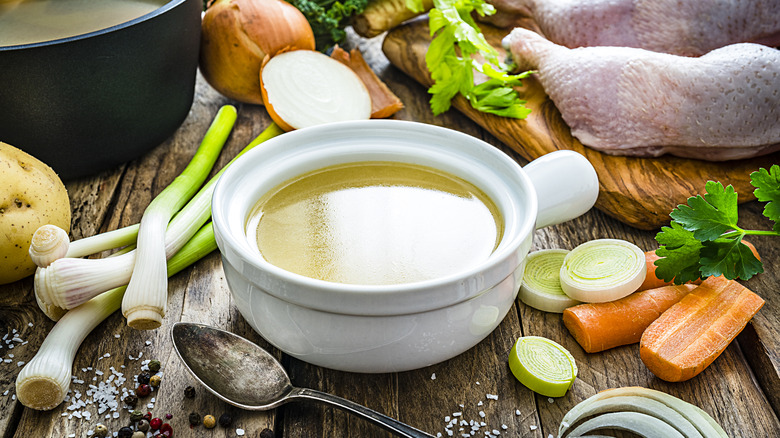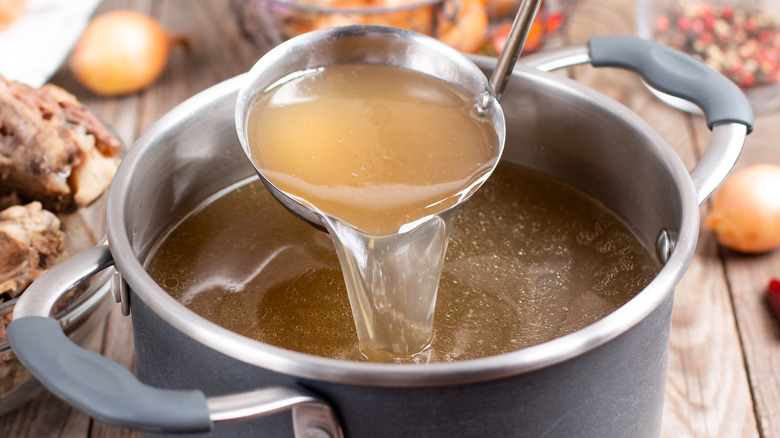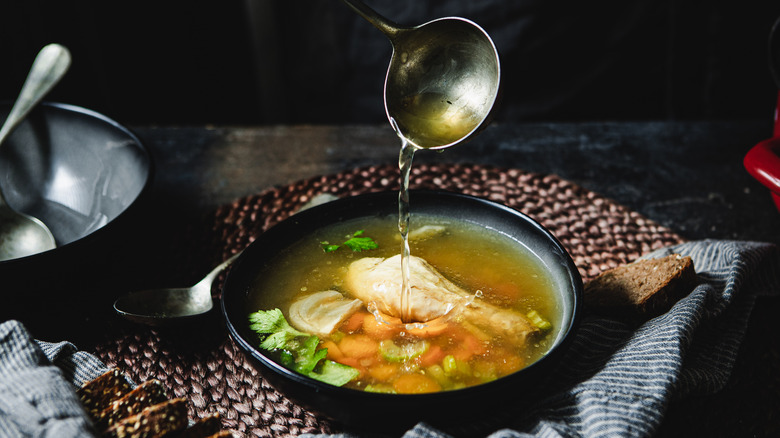Turn Leftover Rotisserie Chicken Into An Easy Homemade Stock
Even after you've picked all the meat off a rotisserie chicken, don't throw it out just yet. Instead, simmer anything left — bones, skin, and all — to make delicious homemade chicken stock. Not only is this a great way to get the most out of your ingredients, but it will also create a full-bodied, collagen-rich concoction.
The stock starts with a chicken carcass (make sure to buy the heaviest rotisserie chicken at the store for extra heft) and builds its flavor through aromatics and vegetables. Onions, carrots, and celery are a classic combination. Cut the veggies into medium-sized chunks rather than adding them whole, as increasing their surface area means they'll release more flavor into the liquid. Next up, herbs are an essential addition to any stock. Parsley is a common choice, but you can use any herbs you like. Finally, add some whole peppercorns and bay leaves to help balance out all the rich flavors.
Once you have your ingredients assembled, add enough water to the pot to just cover everything. You'll want to start with cold water, as heating everything together at the same time will help extract more flavor and gelatin from the chicken bones and skin. Never let the liquid come up to a rolling boil; this can release excess impurities from the bones. Instead, keep the stock at a gentle simmer as it cooks.
How long to cook the stock (and should you skim it?)
Because rotisserie chicken bones are roasted, they will make a darker, cloudier stock than one made with a blanched and simmered chicken carcass. While this stock won't be crystal clear, it will carry major flavor. Expect your creation to be full of toasty, umami-rich notes. Just remember that the skin you're simmering will make for a somewhat salty stock, as rotisserie chicken tends to be high in sodium.
How long you cook your stock dramatically impacts the final product as well. The flavor will become more intense the longer the liquid cooks, as it pulls more fat and collagen from the bones and skin. For most purposes, aim for about four hours of cooking. Keep the pot covered during this process so the liquid doesn't evaporate. If your stock isn't flavorful enough after four hours, keep simmering it, and routinely check the pot.
Many recipes also call for skimming the stock as it cooks. Even at a simmer, a certain amount of impurities will still be released from the bones in the form of foam rising to the liquid's surface. While this won't affect the flavor, it will make the stock look even more cloudy. Fortunately, since we're making a dark stock, this isn't such a big deal for our purposes. Instead of skimming throughout the cooking process, straining the solids through a fine mesh sieve at the end should be enough to remove any lingering foam.
How to use and freeze your stock
Stock made from a single rotisserie chicken should yield about 2-4 quarts after it's been strained. Of course, you can use it to whip up a classic chicken noodle soup recipe, but this liquid gold also has many other uses. A homemade stock absorbs plenty of gelatin from the chicken bones. This makes it a perfect choice for a pan sauce, where the gelatin gives it body as the liquid reduces. Or, for a quick way to improve side dishes, swap out water for your homemade stock next time you make rice or polenta.
The USDA states that stock can be kept in the refrigerator for up to three days; freezing stock is an excellent way to make it last longer. Freezer-safe ziplock bags are a great storage option because they can be stacked flat before freezing to minimize space. Any freezer-safe container, like a mason jar or a plastic quart container, will work well too. Make sure to label your container so you know when it was frozen. The stock should stay at its best in the freezer for two to three months, though its quality will begin to degrade after that period.



